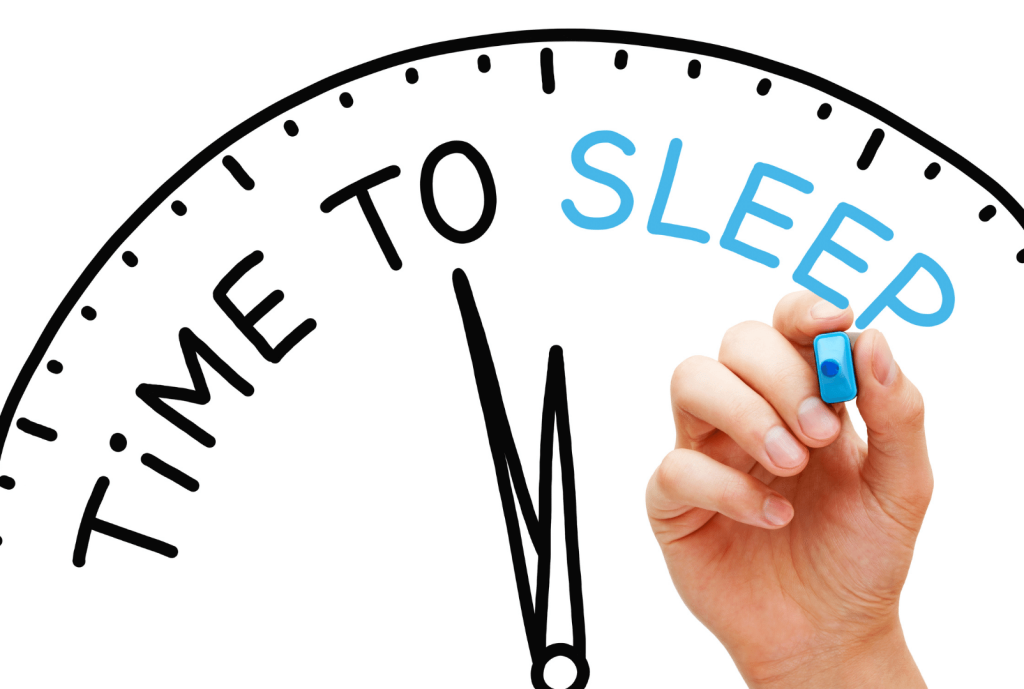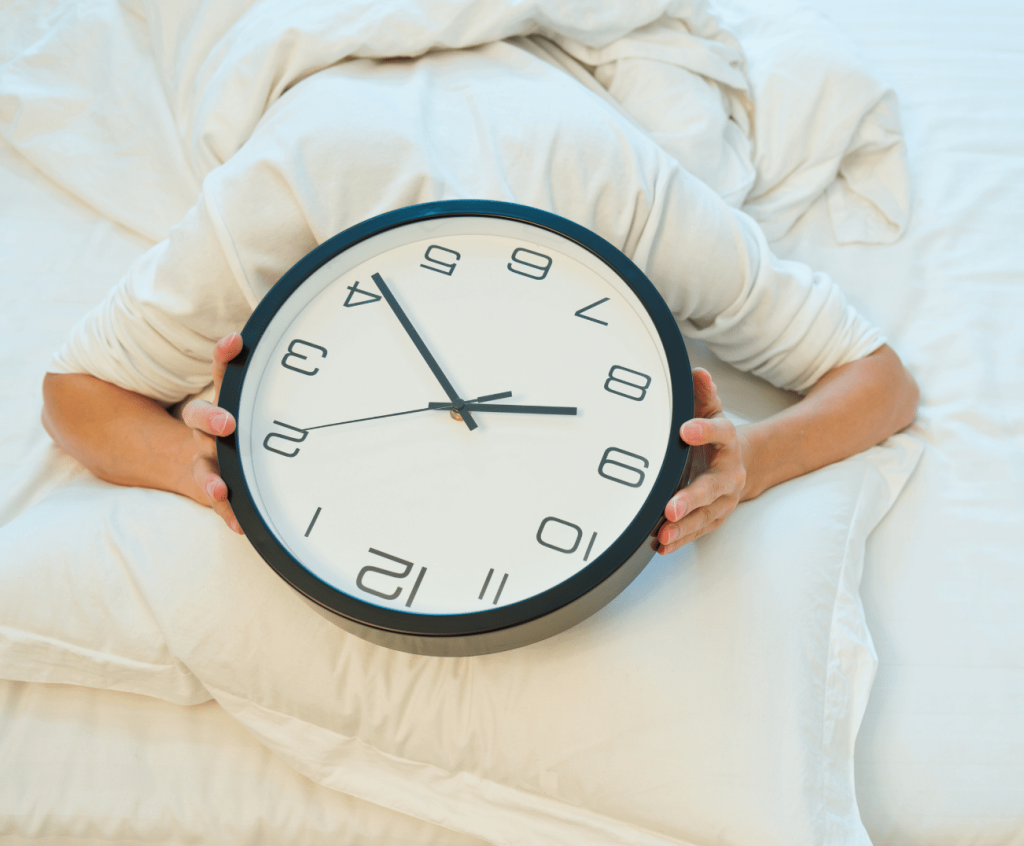What Is The Circadian Rhythm? How To Reset It and How To Have a Healthy One?

A healthy circadian rhythm is critical to your overall well-being. You may associate it mainly with sleep patterns, but it affects numerous systems and processes in your body.

Being misaligned with your circadian rhythm affects every cell in your body, and may contribute to suboptimal health, body composition, and performance. In this article, you’ll learn more about your circadian rhythm and how to optimize your habits to have a healthy one.
What Is A Circadian Rhythm?
A circadian rhythm is a 24-hour biological cycle that includes physical, mental, and behavioral changes. And it’s not only for humans. Plants, animals, and even microbes have circadian rhythms too. Some may also call it the day-night cycle or your body’s internal clock.
It’s like a programmed system for your body. Every day at around the same time, your body goes through the same changes, day in and day out.
Aside from helping you fall asleep at night and wake up in the morning, your circadian rhythm also helps regulate:
- Your hormonal activity
- Eating, appetite, and digestion
- Your body temperature
- Detoxification and elimination
These processes begin in the womb and continue to develop through the first few years of life. When you are first born, your circadian rhythm exists primarily without environmental cues. Over time, your circadian rhythm matures and aligns with the day and night natural light cycles.

Light is the most potent regulator of your circadian rhythm. Your retina is the area in the back of your eyeballs with many light receptors, such as the rod and cone cells. Some of these cells also tell your brain what time it is based on the light input.
A type of light receptor in your retina called intrinsically photosensitive retinal ganglion cells (ipRGCs), is what researchers believe communicates directly with your body’s master clock.
This master clock is called the suprachiasmatic nuclei (SCN) in your hypothalamus. The SCN has about 20,000 nerve cells. It is your circadian rhythm acting like a pacemaker or clock pendulum for your body. The SCN then coordinates with various clocks throughout the body using hormonal and neural signals.
Your circadian rhythm is unique to you. Some people are naturally early birds, while others are night owls. This uniqueness is called your chronotype.
Circadian Rhythm Zeitgebers Or Things That Influence Your Circadian Rhythm
Environmental or behavioral cues, called zeitgebers, heavily influence the secondary clocks throughout your body.
What you do throughout the day and night trains these clocks. The tricky part is that the master clock generally doesn’t change. So, if the cues you give your body throughout the day don’t align with the SCN, your circadian rhythm becomes misaligned.
1. Light Exposure
Think back to earlier times without electricity. There was only the sun’s natural light to regulate your circadian rhythm. Sunlight signaled people to wake up and to get sleepy as the daylight faded into the night. There were no alarm clocks to get you up earlier or screens to stare into at night.
Artificial light makes it easier to see and improves safety. Because light is the primary regulator of the circadian rhythm, it should be no surprise that light exposure at the wrong times can seriously affect your circadian rhythm.
We know that light exposure affects the circadian rhythm by examining melatonin levels. Melatonin levels in your body have their own natural cycle. They are low in the morning and throughout the day, and high at night.
When your photoreceptors in your retina receive cues via the hypothalamus that it is getting darker, your pineal gland begins to release melatonin to ease you into a calm state and ready for sleep.
A literature review of 13 studies examined the effects of light on circadian rhythm. Two main factors of light affect the circadian rhythm: intensity and color. Light exposure suppressed melatonin in all subjects. The more intensely bright a light was, the more melatonin it suppressed. It took roughly 30 minutes for their melatonin levels to recover after exposure.
When exploring various light colors, researchers examined the effects of blue, red, and green lights. Those subjects exposed to blue light experienced greater melatonin suppression than green light. And the longer the exposure, the more the blue light suppressed it.
Intermittent exposure to red light during the night did not inhibit melatonin production.
When you use your smartphone, tablet, or other LED screens, you expose yourself to blue light that may shift your circadian rhythm. A literature review explored the effects of artificial light on circadian rhythm. They found that individuals who used their smartphones before bedtime experienced poorer sleep quality and took longer to fall asleep. Using “night mode” on your device changes the color balance and may diminish the effects of light exposure.
While light exposure at night delays your circadian rhythm, morning light advances it. Sunlight is so powerful in anchoring your circadian rhythm because of its brightness. Sunlight is 200 times brighter than indoor light in direct sun and 50 times brighter in daylight. You might not notice these differences because your pupils dilate to adjust. However, If you don’t get any sun exposure during the day, exposure to artificial blue light from screens and light bulbs at night can strongly disrupt your circadian rhythm.
When your circadian rhythm either advances by beginning earlier in the day or is delayed at night, it is called phase shifting. Even as short as five minutes or intermittent flashes of bright light exposure can shift your circadian phase.
2. Mealtimes
Hormones that influence eating, digestion, and elimination fluctuate based on day-night cycles:
- They influence how your body breaks down food, and either uses or stores it for energy
- Your appetite-regulating hormones follow your circadian rhythm
When your meal-eating behavior doesn’t align with your natural rhythm, it can lead to circadian misalignment.
The largest body of studies on the effect of mealtimes on the circadian rhythm is with night shift workers who naturally eat out of phase. They also have higher occurrences of:
- Obesity
- Type 2 diabetes
- Cardiovascular disease
In a study aimed at deepening understanding of meal timing on circadian-related rhythms, 20 subjects ate dinner at either 6:00 p.m. or 10:00 p.m. with the same fixed sleeping time from 11:00 p.m. until 7:00 a.m. Those who ate a late dinner experienced a four-hour shift in the postprandial period responsible for energy metabolism, which overlapped with the sleep phase.
While the shift in meal timing did not affect participants’ sleep patterns, it did result in metabolic changes, such as an increase in glucose intolerance and a reduction in fatty acid breakdown. Chronic recurrence of these conditions may promote obesity.

3. Physical Activity
Daily physical activity, especially at the same time each day, strengthens your circadian rhythm.
A recent meta-analysis examined the effects of physical activity on the circadian rhythm. Overall, researchers found that physical activity directly strengthens the output from the SCN to decrease circadian rhythm disruption. When exercise occurs at the same time during the day and for the same duration, this further strengthens the circadian rhythm.
The same meta-analysis found that exercising outdoors increases exposure to natural bright light and helps align the circadian rhythm. Physical exercise is most effective when it is voluntary and fun.
One aspect of the circadian rhythm that physical activity directly affects is your body temperature. Your body temperature naturally fluctuates throughout the day with a change of about 1.8 degrees Fahrenheit or one-degree Celsius from day to night.
Higher levels of physical activity result in a more synchronized temperature rhythm throughout the day and night. When this rhythm is out of whack, it can result in sleep disturbances and disruptions in your immune system.
The time of day you exercise is important for maintaining a proper rhythm for energy metabolism.
A literature review of 66 studies explored this very topic. It turns out that what’s best for you depends on your chronotype. Early birds perform better in the mornings, and night owls perform better in the evenings. Early birds exercising in the evening may affect their sleep pattern.
Another study of 48 fit young adults highlights that morning or early afternoon exercise can shift your circadian rhythm forward and stimulate earlier melatonin release. The effect disappears when exercising after 4:00 pm and can delay circadian rhythm when exercise takes place after 7:00 pm.
4. Bedtime
We all know that sleep is critical, and it’s the most overt action of your circadian rhythm. What time you go to sleep at night can either align or misalign your rhythm.
A meta-analysis examining sleep timing and circadian rhythm tells us it’s relatively simple: your chronotype determines your best timing. If you avoid other factors like bright or blue light exposure, and eating and exercising late in the day, you can feel confident in listening to and following your body’s cues for sleep.
Maintaining a consistent bedtime is the most important thing to ensure a healthy circadian rhythm.
What Happens When The Circadian Rhythm Is Disrupted?
Your circadian rhythm regulates many physical and biological processes and, if disrupted, your health can be seriously affected. When your behaviors (like eating, bedtime, and meal times) and your environment (like artificial light exposure) don’t align with your body’s natural circadian rhythm, it creates a misalignment in your tissues and organs.
The majority of us are at risk for circadian disruption:
- 99% of the world’s population experiences light pollution
- 70% of people work indoors and lack natural light exposure
- 16% of people work a night shift schedule
If you are a night owl, you’re even more likely to experience circadian disruption because social and professional responsibilities tend to occur during hours more aligned to early birds.
How circadian disruption affects you depends on whether it is short-term or long-term. Short-term disruption, like experiencing jet lag or a change in sleep schedule based on a work week vs. a weekend can result in:
- Sleepiness
- Memory issues
- Increased response to stress
- Emotional distress
- Physical discomfort
- Increased appetite
- A reduced ability to enjoy activities due to reduced physical, cognitive, and social skills
Long-term circadian disruption puts you at higher risk for:
- Sleep disorders
- Cardiovascular disorder (CVD)
- Metabolic dysfunction – possibly leading to obesity, hypertension, type 2 diabetes, high blood sugar levels
- Neurodegenerative diseases – such as Alzheimer’s, Huntington’s, and Parkinson’s diseases
- Infertility
- Cancer
- Psychological disorders – Disruption can cause mood changes or advance other disorders such as seasonal affective disorder (SAD), bipolar disorder, depression, schizophrenia, and autism spectrum disorder
Keep in mind, these conditions involve many factors and unhealthy circadian rhythm is only one of them.
Hormone secretion, core body temperature, and metabolic activity determine your performance in any given activity. When your circadian rhythm is disrupted, you become less alert and have decreased cognitive function.
A meta-analysis explored the effects of circadian disruption on performance. Healthy subjects following normal light-dark schedules had the highest daytime physical performance and efficiency levels. These levels began to decrease in the evening and reached the lowest level by 2:00 am. This is also the time when your body temperature reaches its lowest.
With decreased performance comes an increased risk of accidents and safety concerns. Major disasters such as the Exxon Valdez oil spill and the Chernobyl nuclear accident happened during these late-night hours, making it very possible that circadian dysfunction played a role.
So now that I’ve got you possibly concerned about your own health habits and potential risks in your life, read on to the next section to find out how to get you and your circadian rhythm back on track.
How To Reset Your Circadian Rhythm

It’s pretty easy to knock your circadian rhythm out of sync. Whether you’re experiencing jet lag, spending a night out with friends, having a late meal, or disrupting your circadian rhythm in some other way, the good news is that it’s not too late to reset it. It will take some effort and a good dose of consistency. This is what you need to do:
1. Maintain A Regular Sleep Schedule
Go to bed and wake up at the same time. Every night. Even on the weekends. And do it all while listening to your body’s natural clues.
It’s unreasonable to think you can shift it in just one night. Start gradually by going to bed earlier by about 15 minutes each night and waking up about 15 minutes earlier each morning until you reach your target time.
A study of 23 healthy young adults compared the effects of unstructured and structured sleep on the circadian rhythm. Compared to unstructured sleep, when subjects on a sleep schedule experienced:
- Earlier sleep and wake times
- Less variability in total sleep time
- Circadian phase shift
Check out this blog post on How to Maximize Your Sleep Quality for our best tips.
2. Expose Yourself To Bright Light
But not at night. You already knew that. Bright light exposure, especially the sun, has a powerful effect on the circadian rhythm by making it more synchronized.
An animal study explored the ability of bright light to reset the circadian rhythm to align it with the natural light/dark cycle. Mice exposed to bright light experienced a more synchronized rhythm, while those only exposed to dim light were out of sync with the SCN master clock.
Getting outside to catch some rays or using light therapy is a significant step to getting yourself back on track.
Wearing blue-light-blocking glasses effectively prevents blue light exposure at the wrong times, like into the evening.
A meta-analysis of 29 studies examined blue-blocking glasses’ effects on individuals struggling with sleep onset. While wearing blue-blocking glasses, subjects fell asleep much more easily than those who did not.
Instead of watching a show or looking at your phone, pick up a book as a circadian rhythm-friendly alternative to wind down your day.
3. Take Melatonin, But Only Very Occasionally
Taking melatonin on occasion can be helpful to help reset your circadian rhythm. This is especially true in cases like when you’re experiencing jet lag. It is not a long-term solution, however. Read Why You Shouldn’t Take Melatonin To Sleep for a deep dive into how and when to take melatonin.
4. Change Your Meal Times
Nowadays, food is constantly available, making it easy to eat anytime day or night. This is also a great way to mess up your rhythm. The more of a routine you have with eating, the better off you’ll be. Schedule your meal times and stick to them every day while also ensuring not to eat later than about four hours before your natural bedtime.
Also, avoid foods high in caffeine, sugar, and fat before bed. While caffeine can be a great energy booster, it takes about 5 hours to break down in your body. If you’re going to have a high-fat meal, it’s best to eat it about eight hours after you start your day– think for your lunch or late lunch, but not after, to avoid metabolic disruption.
5. Exercise Regularly
Your circadian rhythm responds well to exercise. And once again, it’s all about timing. Scheduling regular exercise at the same time each day helps resynchronize your circadian rhythm.
A meta-analysis explored how to reset circadian rhythm. Researchers found that even in completely dark conditions, animals who exercise in the middle of the day experience a phase shift causing them to exercise earlier the next day.
Re-alignment with the circadian rhythm with exercise happens even more rapidly when paired with appropriate lighting exposure, as discussed above, throughout the day. While more animal studies are available than human studies, human studies demonstrate similar results.
Just like the circadian rhythm is all about the schedule, so do you need to be to reset yours.
How Long Does It Take To Reset Your Circadian Rhythm?
The amount of time it will take you to reset your circadian rhythm is very individual. The more consistent you are, and the more strategies you adopt from the section above, the more quickly it can occur.
While the circadian rhythm resets itself roughly every 24 hours, when disrupted, your circadian rhythm takes a bit longer than that. What researchers know about circadian rhythm reset in humans is most commonly studied in the context of jet lag. And in those cases, it takes about 1 to 2 days to reset itself when traveling within the same time zone. And about one extra day for each time zone crossed.
In an animal study using mice with a 24-hour circadian rhythm, researchers examined how long it took the circadian rhythm to reset after circadian disruption for three days. Half of the mice reset to their baseline after six days. Those that took longer to reset were much more active, indicating a possible underlying condition preventing a quick recovery.
So what does this tell us? If you are serious about resetting your circadian rhythm and consistently follow the suggested strategies, it should take you less than a week to fully reset your circadian rhythm. If you continue to struggle, you should speak with your doctor to see if there are underlying reasons preventing you from succeeding.
Takeaway
Having a healthy circadian rhythm is critical to your physical and mental well-being. It’s also easy to disrupt it in this modern world of travel, artificial light, eating and staying out late, or not staying active. You can support a healthy circadian rhythm by:
- Maintaining consistent bedtimes and wake times
- Eating your meals at the same time each day and avoiding late meal times
- Exercising regularly around the same time each day
- Getting outside and soaking up some natural light
And if you do not see expected results after consistent effort, speak to your doctor about any possible underlying health conditions.
- Wong SD, Wright KP Jr, Spencer RL, et al. Development of the circadian system in early life: maternal and environmental factors. J Physiol Anthropol. 2022;41(1):22. doi:10.1186/s40101-022-00294-0
- Paul KN, Saafir TB, Tosini G. The role of retinal photoreceptors in the regulation of circadian rhythms. Rev Endocr Metab Disord. 2009;10(4):271-278. doi:10.1007/s11154-009-9120-x
- Masters A, Pandi-Perumal SR, Seixas A, Girardin JL, McFarlane SI. Melatonin, the hormone of darkness: From sleep promotion to Ebola treatment. Brain Disord Ther. 2014;4(1). doi:10.4172/2168-975X.1000151
- Tähkämö L, Partonen T, Pesonen AK. Systematic review of light exposure impact on human circadian rhythm. Chronobiol Int. 2019;36(2):151-170. doi:10.1080/07420528.2018.1527773
- Blume C, Garbazza C, Spitschan M. Effects of light on human circadian rhythms, sleep and mood. Somnologie (Berl). 2019;23(3):147-156. doi:10.1007/s11818-019-00215-x
- Boege HL, Bhatti MZ, St-Onge MP. Circadian rhythms and meal timing: impact on energy balance and body weight. Curr Opin Biotechnol. 2021;70:1-6. doi:10.1016/j.copbio.2020.08.009
- Gu C, Brereton N, Schweitzer A, et al. Metabolic effects of late dinner in healthy volunteers-A randomized crossover clinical trial. J Clin Endocrinol Metab. 2020;105(8):2789-2802. doi:10.1210/clinem/dgaa354
- Weinert D, Gubin D. The impact of physical activity on the circadian system: Benefits for health, performance and wellbeing. Appl Sci (Basel). 2022;12(18):9220. doi:10.3390/app12189220
- Baker FC, Waner JI, Vieira EF, Taylor SR, Driver HS, Mitchell D. Sleep and 24 hour body temperatures: a comparison in young men, naturally cycling women and women taking hormonal contraceptives. J Physiol. 2001;530(3):565-574. doi:10.1111/j.1469-7793.2001.0565k.x
- Coiffard B, Diallo AB, Mezouar S, Leone M, Mege JL. A tangled threesome: Circadian rhythm, body temperature variations, and the immune system. Biology (Basel). 2021;10(1):65. doi:10.3390/biology10010065
- Mirizio GG, Nunes RSM, Vargas DA, Foster C, Vieira E. Time-of-day effects on short-duration maximal exercise performance. Sci Rep. 2020;10(1):9485. doi:10.1038/s41598-020-66342-w
- Youngstedt SD, Elliott JA, Kripke DF. Human circadian phase-response curves for exercise. J Physiol. 2019;597(8):2253-2268. doi:10.1113/JP276943
- Sanchez REA, Kalume F, de la Iglesia HO. Sleep timing and the circadian clock in mammals: Past, present and the road ahead. Semin Cell Dev Biol. 2022;126:3-14. doi:10.1016/j.semcdb.2021.05.034
- Fishbein AB, Knutson KL, Zee PC. Circadian disruption and human health. J Clin Invest. 10 2021;131(19). doi:10.1172/JCI148286
- Medic G, Wille M, Hemels ME. Short- and long-term health consequences of sleep disruption. Nat Sci Sleep. 2017;9:151-161. doi:10.2147/NSS.S134864
- Samanta S, Ali SA. Impact of circadian clock dysfunction on human health. Explor Neurosci. 2022;1(1):4-30. doi:10.37349/en.2022.00002
- McMahon WR, Ftouni S, Phillips AJK, et al. The impact of structured sleep schedules prior to an in-laboratory study: Individual differences in sleep and circadian timing. PLoS One. 2020;15(8):e0236566. doi:10.1371/journal.pone.0236566
- Bano-Otalora B, Martial F, Harding C, et al. Bright daytime light enhances circadian amplitude in a diurnal mammal. Proc Natl Acad Sci U S A. 2021;118(22):e2100094118. doi:10.1073/pnas.2100094118
- Hester L, Dang D, Barker CJ, et al. Evening wear of blue-blocking glasses for sleep and mood disorders: a systematic review. Chronobiol Int. 2021;38(10):1375-1383. doi:10.1080/07420528.2021.1930029
- Schroeder AM, Colwell CS. How to fix a broken clock. Trends Pharmacol Sci. 2013;34(11):605-619. doi:10.1016/j.tips.2013.09.002
- Institute of Medicine (US) Committee on Military Nutrition Research. Pharmacology of Caffeine. National Academies Press; 2001.
- Sack RL. Clinical practice. Jet lag. N Engl J Med. 2010;362(5):440-447. doi:10.1056/NEJMcp0909838
- Jung SH, Park JM, Moon E, et al. Delay in the recovery of normal sleep-wake cycle after disruption of the light-dark cycle in mice: a bipolar disorder-prone animal model? Psychiatry Investig. 2014;11(4):487-491. doi:10.4306/pi.2014.11.4.487





